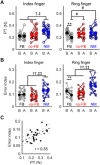Overcoming the ceiling effects of experts' motor expertise through active haptic training
- PMID: 33219034
- PMCID: PMC7679166
- DOI: 10.1126/sciadv.abd2558
Overcoming the ceiling effects of experts' motor expertise through active haptic training
Abstract
One of the most challenging issues among experts is how to improve motor skills that have already been highly trained. Recent studies have proposed importance of both genetic predisposition and accumulated amount of practice for standing at the top of fields of sports and performing arts. In contrast to the two factors, what is unexplored is how one practices impacts on experts' expertise. Here, we show that training of active somatosensory function (active haptic training) enhances precise force control in the keystrokes and somatosensory functions specifically of expert pianists, but not of untrained individuals. By contrast, training that merely repeats the task with provision of error feedback, which is a typical training method, failed to improve the force control in the experts, but not in the untrained. These findings provide evidence that the limit of highly trained motor skills could be overcome by optimizing training methods.
Copyright © 2020 The Authors, some rights reserved; exclusive licensee American Association for the Advancement of Science. No claim to original U.S. Government Works. Distributed under a Creative Commons Attribution NonCommercial License 4.0 (CC BY-NC).
Figures



Similar articles
-
Shared somatosensory and motor functions in musicians.Sci Rep. 2016 Nov 25;6:37632. doi: 10.1038/srep37632. Sci Rep. 2016. PMID: 27886250 Free PMC article.
-
Towards functional robotic training: motor learning of dynamic tasks is enhanced by haptic rendering but hampered by arm weight support.J Neuroeng Rehabil. 2022 Feb 13;19(1):19. doi: 10.1186/s12984-022-00993-w. J Neuroeng Rehabil. 2022. PMID: 35152897 Free PMC article.
-
Somatosensory Training Improves Proprioception and Untrained Motor Function in Parkinson's Disease.Front Neurol. 2018 Dec 10;9:1053. doi: 10.3389/fneur.2018.01053. eCollection 2018. Front Neurol. 2018. PMID: 30619029 Free PMC article.
-
Haptic Feedback, Force Feedback, and Force-Sensing in Simulation Training for Laparoscopy: A Systematic Overview.J Surg Educ. 2019 Jan-Feb;76(1):242-261. doi: 10.1016/j.jsurg.2018.06.008. Epub 2018 Aug 4. J Surg Educ. 2019. PMID: 30082239
-
A perspective on the role and utility of haptic feedback in laparoscopic skills training.Crit Rev Biomed Eng. 2014;42(3-4):293-318. doi: 10.1615/critrevbiomedeng.2014011701. Crit Rev Biomed Eng. 2014. PMID: 25597241 Review.
Cited by
-
Enhancement of loudness discrimination acuity for self-generated sound is independent of musical experience.PLoS One. 2021 Dec 7;16(12):e0260859. doi: 10.1371/journal.pone.0260859. eCollection 2021. PLoS One. 2021. PMID: 34874970 Free PMC article.
-
The plyometric activity as a conditioning to enhance strength and precision of the finger movements in pianists.Sci Rep. 2022 Dec 23;12(1):22267. doi: 10.1038/s41598-022-26025-0. Sci Rep. 2022. PMID: 36564388 Free PMC article.
-
Active perceptual learning involves motor exploration and adaptation of predictive sensory integration.iScience. 2023 Dec 1;27(1):108604. doi: 10.1016/j.isci.2023.108604. eCollection 2024 Jan 19. iScience. 2023. PMID: 38155781 Free PMC article.
-
Enhanced Somatosensory Inhibition Sharpens Hand Representation and Sensorimotor Skills in Pianists.J Neurosci. 2025 Feb 19;45(8):e1486242024. doi: 10.1523/JNEUROSCI.1486-24.2024. J Neurosci. 2025. PMID: 39746821 Free PMC article.
-
Haptic Technology: Exploring Its Underexplored Clinical Applications-A Systematic Review.Biomedicines. 2024 Dec 10;12(12):2802. doi: 10.3390/biomedicines12122802. Biomedicines. 2024. PMID: 39767709 Free PMC article. Review.
References
-
- W. R. Boot, K. A. Ericsson, The Oxford Handbook of Cognitive Engineering: Expertise (Oxford Univ. Press, 2013).
-
- Macnamara B. N., Hambrick D. Z., Oswald F. L., Deliberate practice and performance in music, games, sports, education, and professions: A meta-analysis. Psychol. Sci. 25, 1608–1618 (2014). - PubMed
-
- Hambrick D. Z., Burgoyne A. P., Macnamara B. N., Ullén F., Toward a multifactorial model of expertise: Beyond born versus made. Ann. N. Y. Acad. Sci. 10.1111/nyas.13586 (2018). - PubMed
-
- Ullén F., Hambrick D. Z., Mosing M. A., Rethinking expertise: A multifactorial gene–environment interaction model of expert performance. Psychol. Bull. 142, 427–446 (2016). - PubMed
-
- Meinz E. J., Hambrick D. Z., Deliberate practice is necessary but not sufficient to explain individual differences in piano sight-reading skill: The role of working memory capacity. Psychol. Sci. 21, 914–919 (2010). - PubMed
Publication types
LinkOut - more resources
Full Text Sources

